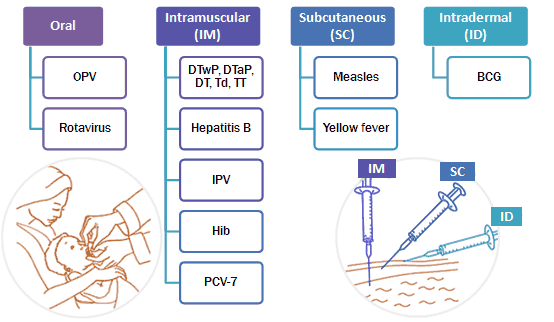Route of administration

The route of administration is the path by which a vaccine (or drug) is brought into contact with the body. This is a critical factor for success of the immunization. A substance must be transported from the site of entry to the part of the body where its action is desired to take place. Using the body's transport mechanisms for this purpose, however, is not trivial.
Intramuscular (IM) injection administers the vaccine into the muscle mass. Vaccines containing adjuvants should be injected IM to reduce adverse local effects. Subcutaneous (SC) injection administers the vaccine into the subcutaneous layer above the muscle and below the skin.

Intradermal (ID) injection administers the vaccine in the topmost layer of the skin. BCG is the only vaccine with this route of administration. Intradermal injection of BCG vaccine reduces the risk of neurovascular injury. Health workers say that BCG is the most difficult vaccine to administer due to the small size of newborns' arms. A short narrow needle (15 mm, 26 gauge) is needed for BCG vaccine. All other vaccines are given with a longer, wider needle (commonly 25 mm, 23 gauge), either SC or IM.
Oral administration of vaccine makes immunization easier by eliminating the need for a needle and syringe.
Intranasal spray application of a vaccine offers a needle free approach through the nasal mucosa of the vaccinee. Click on the More About link for an example of an intranasal flu vaccine.

Key point
Manufacturers usually recommend the route of administration that limits best adverse reactions of the respective vaccine.

